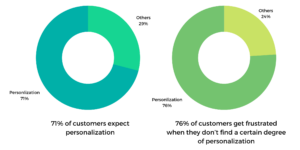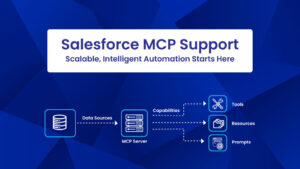In a world as connected and digitally sound as today, customers choose to select the businesses they want to engage with. As most of the world has shifted online post the COVID-19 pandemic, the rise of services, products, and content-on-demand is an opportunity and a challenge at the same time. Customers today know what they want, who they want it from, and what to look for in the businesses they want to buy from. And, it just doesn’t stop there.
Your customers today aren’t inclined to just hear from you; they want to hear from you directly—messages and other notifications that are personalized and contextual. According to McKinsey’s Next in Personalization Report 2021, a whopping 71% of customers expect personalization in terms of messaging or products and services from businesses. Companies that engage in personalization activities generate 40% more revenue than the average players. Moreover, 76% of customers get frustrated when they don’t find a certain degree of personalization in their messaging.

(McKinsey’s Personalization Report 2021)
If you’re a marketer in today’s day and age, you don’t want to contact your potential customers and look like a spammer. The journey from a cold call to the final decision-making process is a long, engaging, and, if done rightly, ROI-positive one. However, to ensure that your sales team is making that journey an engaging and value-driven one, you shall have a process in place.
Although, with the number of efforts involved in ensuring that your leads are only served, a communication that’s tailor-made for them is a far-fetched one. Hence, to ensure that your customers are communicated with relevant information, you need to automate how you stay in touch with them regularly without seeming too pushy. This is where a well-thought lead-nurturing strategy comes into play.
Lead nurturing, essentially, is the process of staying in touch with your leads throughout the customer’s journey and all the phases of the life cycle. It is entirely plausible to assume that most of your potential customers might adopt a different journey, from the introduction to the decision-making stage. Some might visit your website continuously; others might be opening your emails often to see what you’ve got to offer.
Learn how an efficient lead-nurturing strategy can help your sales and marketing teams to improve how they communicate with your potential leads.
What is lead nurturing?
Imagine yourself in a B2B customer’s shoes. You are facing a pain point in your business’ operations and hence start with your most basic instinct, i.e., a basic Google search to alleviate that pain.
This is the most common and often the first step that any of your prospect B2B leads might take. During this stage of independent research, a B2B customer is on the lookout for the right information that helps them with the issue they are currently facing when it comes to their business. When they get access to a piece of resource or information that provides some value-driven information about their pain point, they are looking forward to creating a meaningful relationship with them.
So, based on this scenario, lead nurturing is a strategic process of figuring out what buyers might find valuable during the tenure of the relationship with your organization and providing them with that information at the right time. It is an automated process that incentivizes your leads with a consistent supply of relevant information and gives them value at each stage. This process continues until they have enough valuable information to make a buying decision.
Why is lead nurturing important?
A thorough lead nurturing strategy gains from the right degree of automation at critical places. According to a source, marketing automation in lead nurturing brings a massive 451% increase in qualified leads.
The entire nurturing strategy can achieve automation and communicate with your leads through contextual messaging that doesn’t look like a spam email. With lead nurturing, your leads receive targeted communications based on their activities, interests, and more. So, what should you expect when you deploy a full-fledged lead nurturing strategy? Here are some of the benefits:
-
Lesser time, efficient results
Contrary to the general perception, good lead nurturing can save a lot of time in your entire sales process. Say a sales team employee can engage a lead way too early in the process. This is when they will have to explain the process right from scratch and cater to more and more questions.
A well-executed lead nurturing strategy can educate your leads early on in the journey before a lead communicates with your sales team. The initial purpose of lead nurturing is to educate your potential lead around the pain point they are trying to find a solution for and still not feel much pushy.
-
Reaching out again
As you gain more and more leads in your database through your marketing efforts, it gets a little haphazard to manage it all in one go.
In this process of a growing database, there is a chance that the older leads might get overshadowed when the newer ones come on board. A lead nurturing campaign is a great way to revive the dormant leads. The key here would be to treat these people like someone you just lost touch with and are trying to reach out to them again. Hence, a direct call to the action-driven campaign isn’t the way to go.
Reel them in by sending educational information pieces. This process will further allow you to weed out the leads that seem to be inactive and the ones that are looking to look more into the services you are providing. A lead nurturing process with older leads can further fasten up your sales process, as your sales team already knows whom you shall engage with and whom you shall not.
-
Personalize Messages
A lead nurturing strategy can not just automate your process of engaging with the right leads but personalize it to an altogether new level. You can send personalized communication to prospects based on their activity.
With more such elements, like using a signature from one of your sales reps to make the email seem more human to including a conversational tone of voice, there’s a lot that can be achieved. Moreover, you can achieve a strong degree of personalization even if you’re communicating at scale with your prospect leads.
-
Automate to save on time and resources
With your marketing and sales team focusing on many other duties, there’s a strong chance that your team can miss out on potential leads by not following upon them. However, with a lead nurturing strategy, this task can be automated based on their past interactions. This allows the sales reps to focus on leads that have just entered the ecosystem and acclimatize them by supporting them if and where necessary.
-
Nurture across lifecycle
While lead nurturing is an excellent way to get in touch with your prospect leads, it can help you gain the attention of your existing and new clients.
A lead nurturing campaign focusing on your newer services offerings and welcoming them into your business is an excellent way to communicate and engage with them. For a newly on boarded client, an information guide, best practices help book, etc., can be a good piece of valuable information. Moreover, you can also nurture your existing clients by upselling them newer packages, renewals, loyalty discounts, etc.
This can be an excellent method to onboard new employees and train them.
What goes behind a lead nurturing campaign?
Now that you’re well adept with what a lead nurturing campaign is and why your business should get on board, let us help you learn about the elements involved in it. Here are some steps to set up a successful lead nurturing program:

(Steps for Lead Nurturing Campaign)
Step 1: Choose the campaign
There are various kinds of campaigns you can run to nurture a lead. This depends upon what your goals are to achieve out of this activity. There are tons of lead nurturing campaigns you can look into. For instance, a welcome campaign, an upsell campaign, a top-of-mind campaign, etc.
Hence, this is the most crucial decision before taking the next step.
Step 2: Choose your list
Once you have selected the purpose and type of campaign, you can target the right people you want the campaign to be sent to.
Lead nurturing allows you to target a specific set of audiences, depending on different parameters such as location, new or old users, and more. Choosing the right list will allow you to target a particular set of people with more detailed and contextual communication.
Step 3: Decide on a flow
A flow will be the process of your leads receiving any form of communication from you. To decide a flow for your lead nurturing activity, you need to consider a few things.
- Frequency: Decide on a frequency, depending upon the first step. If your campaign targets long-term inactive leads, you’ll need a long-term sales cycle with the communication spread out across a few days. On the other hand, a client onboarding mail should be right on time, with the right frequency of materials available at their disposal. This will allow them to know your services and work even better during your relationship.
- Complexity: Every lead nurturing campaign is different. Each campaign can be set separately depending on how complex or simple you want it to be. Nurturing campaigns can be set linearly, where leads will progress through the campaign in straight lines or different branches that will get active as they respond to a mail.
- The Trigger: Lead nurturing works best with a trigger available at each step. Actions like opening a mail, clicking on a link, downloading a guide, or an eBook can be that trigger. This allows marketers to deliver highly-relevant and contextual messages to a lead at each trigger’s activity.
Step 4: Decide the content you’d like to offer
Every campaign has a suitable form of content. You shall go for the content ideal for the type of campaign you’re creating. Say, for instance, if it’s a simple lead nurturing track for sales leads, go for tailor-made content based on the client’s history and past activity.
According to a study, our attention span has decreased by 33% since the beginning of the century. The type of content you choose should be interesting and be able to grab your lead’s attention in one go and should make them read further down the line. You can take this step further by creating a user persona for each of your target groups, helping you personalize your messages even further.
Step 5: Activate and Analyze
After ensuring that you’ve covered all the aforementioned aspects, deploy your nurturing program and track it at each stage.
Lead Nurturing Best Practices
Once you’re adept with the intricacies above, going through the lead nurturing best practices is a good idea. This will help you avoid unethical practices and not sought-after practices in lead nurturing, such as spamming your leads and optimizing your information for conversion. Moreover, you need to ensure that your valuable and well-researched information reaches the right people at the right time.
Here are some best lead nurturing practices that can help you longer:
-
Involving your sales team
Making your sales team a more involved component of your lead nurturing process can pay dividends down the road. While the marketing team does its job and the lead nurturing process is automated, the sales reps have real-world insights.
Sales teams are in direct contact with leads and hence can understand the pain points of each prospect.
Touching base with your sales team can help you streamline your communication strategy and work in tandem with where a specific lead is in the customer journey process.
-
Target your communications
Lead nurturing is most sought-after and yet common feature is its ability to target. Targeting the right communication towards the right people is an underrated capability. Always make sure that whenever you can, target as narrowly as possible.
The segmentation possibilities allow you to segment your leads into different targeted lists from the database. These different targeted lists can be catered to different types of content.
-
Make it easy to unsubscribe
As unproductive as it might sound, allowing people to unsubscribe easily is an essential part of your customer journey. If you don’t provide one or make it difficult to unsubscribe from a list, there’s a chance of you getting blacklisted quite soon. Make it evident that your customers are still in control of what they can see and which emails they should receive.
-
Include Clear Call To Actions
Every lead nurturing communication should have a purpose involved. This purpose can be fulfilled by providing an explicit action to your lead that you expect them to take after looking at your content.
The call to action can be downloading an eBook, clicking on a link, etc. You need to ensure that your CTA is visibly placed well within the content. Moreover, using a similar color scheme in a set of your mails for a call to action button can be a good idea to make your lead more familiar with it.
-
Text-based over HTML
A simple text-based email with a personalized signature can do wonders when communicating with your leads. Instead of going for an HTML-based mail with a higher turnaround time and more complexities, text-based mail can be a better alternative.
-
Strategic with your timing
Time your lead nurturing campaigns and information pieces carefully and at strategically placed intervals. Look at the available data sources and try to figure out the best time when your information content might be valuable for them or when they might look at it.
-
Create supporting content
To ensure that enough credibility backs your information, create supporting content pieces such as educational videos, blogs, eBooks, and more that allow you to provide an impetus to your lead nurturing efforts. Let’s just put it this way- if lead nurturing is the engine, then the content is the fuel that’s powering it.
In case you’re short on the quantity of content to back up your lead nurturing efforts, there’s no harm in using third-party resources to ensure that you have enough resources to back up your efforts.
Conclusion: Lead Nurturing For Smarter Results
As the landscape changes around the world, so does customer behavior. With most of the customers increasingly relying upon primary research and various resources, it has become a potential goldmine for generating business. However, that might not entirely be true. According to data by InvespCro, almost 80% of new leads do not result in a sale. This is where a thorough lead-nurturing strategy comes into play.
Are you looking for some help with your lead nurturing process? Get in touch with us today, and our representative will help you out with a detailed scope and plan of action tailored for your requirements.





















